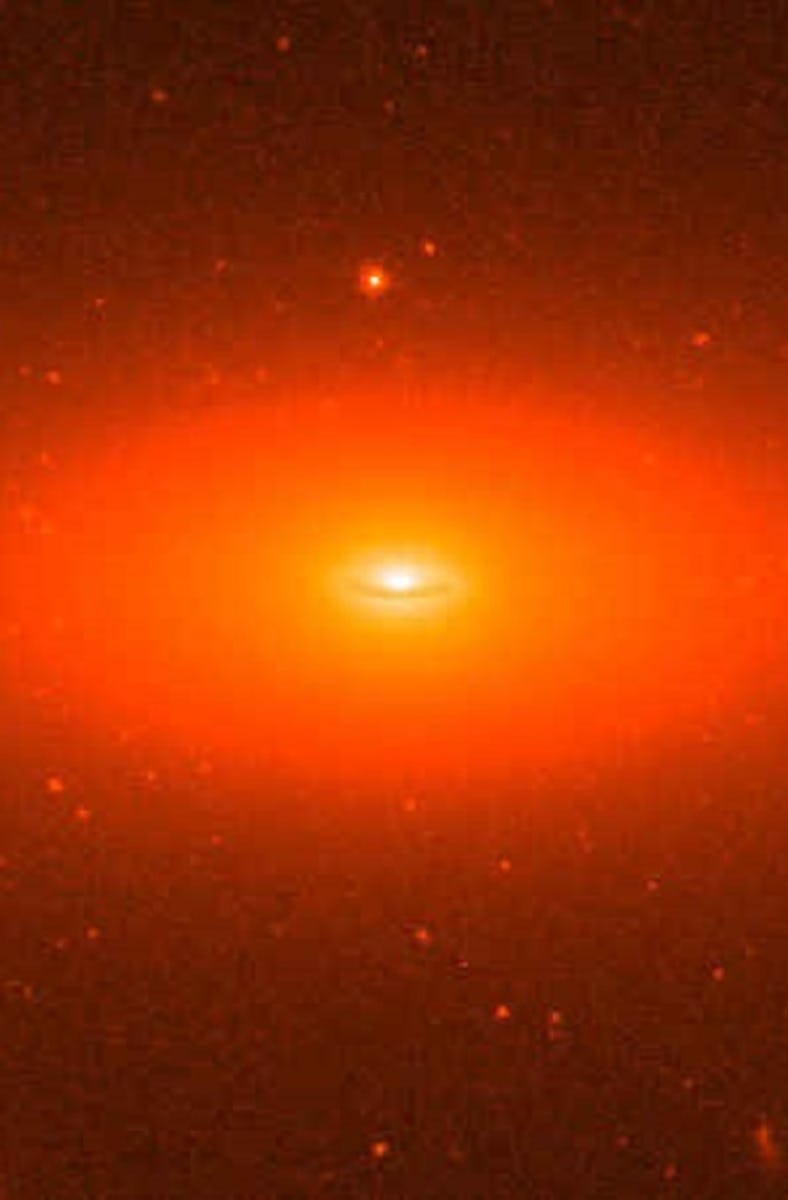Astronomers Discover a Weird Galaxy That Could Change What We Know About Physics
Galaxy NGC 1277 appears to contain no dark matter, which could raise some questions about the standard cosmological model.

Astronomers have found a galaxy that shouldn’t exist — one without dark matter.
Enormous galaxy NGC 1277 was supposed to help Sebastién Comerón of the University of La Laguna and the Instituto de Astrofísica de Canarias learn more about how galaxies evolved in the universe’s distant past, but instead, it threw them a new puzzle. NGC 1277 doesn’t seem to contain any dark matter, the invisible but influential stuff that outweighs the visible universe by almost six to one.
Comerón and his colleagues need to confirm their findings with further observations, but if they’re right, NGC 1277 could be a challenge to our best model of how the universe works — and to at least one of the alternatives.
“This result does not fit in with the currently accepted cosmological models, which include dark matter,” says Comerón in a recent statement. He and his colleagues published their findings in the journal Astronomy and Astrophysics.
The Case of the Missing Dark Matter
Only a tiny fraction of the universe consists of the stuff we can actually see: gas, dust, planets, stars, and galaxies. Another 27 percent or so is dark matter, which doesn’t seem to interact with ordinary matter or energy at all except for its gravitational pull. The rest is dark energy (but that’s a whole different article).
The short version is that most of the mass of the universe is stuff we can’t see, but its gravitational pull plays a key role in sculpting the parts we can see. Or at least, that seems to be the case everywhere except in a huge, lens-shaped galaxy called NGC 1277. Comerón and his colleagues recently mapped the motion of stars, gas, and dust in the galaxy, expecting to find some clues about how large galaxies formed in the early universe. Instead, they found a cosmic mystery.
NGC 1277 is what’s called a relic galaxy. Its stars formed around 12 billion years ago, and somehow, in all that time, it’s managed not to bump into any of its neighbors in the Perseus Cluster. It’s the cosmic version of a well-preserved, undisturbed archaeological site.
“The importance of relic galaxies in helping us to understand how the first galaxies formed was the reason we decided to observe NGC 1277,” says Comerón.
NGC 1277 is 220 million light years away in the Perseus Galaxy Cluster. Its oldest stars formed around 12 billion years ago, making it a relic of galaxy formation in the early universe.
In most galaxies, it’s clear that the motion of the stars is guided by an unseen hand (the gravitational pull of dark matter). But in NGC 1277, the stars and other matter in the galaxy seemed to be moving only under the gravitational influence of the stars. (The fact that matter in other galaxies seemed to move as if it was being pulled by the gravity of something unseen is what first clued astrophysicists in to the existence of dark matter).
Based on Comerón and his colleagues’ observations, if this venerable galaxy contains any dark matter all, it accounts for less than 5 percent of the galaxy’s mass. And that is, to put it in technical terms, super weird.
What Happens Now?
Based on the standard model of how the universe works (aptly named the Standard Cosmological Model), a galaxy the size of NGC 1277 should have enough dark matter to make up between 10 and 70 percent of its mass.
“The discrepancy between the observations and what we would expect is a puzzle and maybe even a challenge for the standard model,” says coauthor Ignacio Trujillo, also of IAC and ULL, in a statement.
And in a fun paradox, the apparent lack of dark matter in NGC 1277 may also offer some evidence against an alternative to dark matter: an attempt to explain what we see in the universe without invoking invisible, untouchable matter. The idea is that gravity may just work differently on very large scales, like the structure of massive galaxies and galaxy cluster, than it does at smaller scales like solar systems. If that’s the case, though, gravity should still work the same way in every large galaxy. An exception like NGC 1277 could refute the whole idea, so we’re back to dark matter – and the puzzle of why it’s missing from one galaxy.
Comerón and his colleagues plan to take a second look at NGC 1277 with the William Herschel Telescope on the island of La Palma, which they hope will shed more light on the missing dark matter.
This article was originally published on